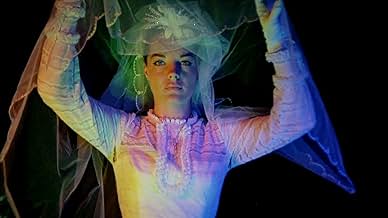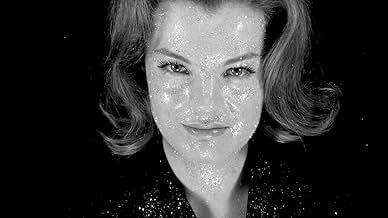Agrega una trama en tu idiomaHenri-Georges Clouzot's unfinished masterpiece, L'enfer (1964), is reconstructed in this film which is part drama and part documentary.Henri-Georges Clouzot's unfinished masterpiece, L'enfer (1964), is reconstructed in this film which is part drama and part documentary.Henri-Georges Clouzot's unfinished masterpiece, L'enfer (1964), is reconstructed in this film which is part drama and part documentary.
- Premios
- 4 premios ganados y 2 nominaciones en total
Romy Schneider
- Odette Prieur
- (material de archivo)
Serge Reggiani
- Marcel Prieur
- (material de archivo)
Dany Carrel
- Marylou
- (material de archivo)
Jean-Claude Bercq
- Martineau
- (material de archivo)
Mario David
- Julien
- (material de archivo)
André Luguet
- Duhamel
- (material de archivo)
Maurice Garrel
- Le docteur Arnoux
- (material de archivo)
Barbara Sommers
- Madame Bordure
- (material de archivo)
Maurice Teynac
- Monsieur Bordure
- (material de archivo)
Henri Virlojeux
- L'homme sur la terrasse
- (material de archivo)
Blanchette Brunoy
- Clotilde
- (material de archivo)
Henri-Georges Clouzot
- Self
- (material de archivo)
- Dirección
- Guionistas
- Todo el elenco y el equipo
- Producción, taquilla y más en IMDbPro
Argumento
¿Sabías que…?
- ConexionesEdited from L'enfer (1964)
Opinión destacada
This is not legend ,this is fact:HG Clouzot was one of the most important French directors of all time .He is the sole Frenchie who enjoys two movies in the IMDb top 250 and that means something for someone who worked before (and a bit) beyond the N.V.
The New Wave was one of the reason why HG Clouzot tackled a work which finally almost killed him.He was trashed by the Young Turks and he wanted to prove them that he too was able to produce creative innovative movies.Actually he had nothing to prove for,although he made only eleven movies and a half ,all of those movies (but one :"Miquette Et Sa Mère" ) were stunning achievements ."Manon" ,for instance,was anything but conventional or academic,transferring a novel from the eighteenth century to the Liberation in 1944."Les Espions" was so ahead of its time nobody in France understood it when it was released .His overlooked short from "Retour A La Vie" predated such works as "death and the maiden" by forty years .And I do not even mention his well-known -and sometimes more praised abroad than in his native country- "Corbeau" "Diaboliques "and "Salaire De La Peur" ,all classics everywhere.
The Nouvelle Vague could do nothing but put this genius down ;he represented all that they hated : elaborate screenplays,tyrannical actors direction(Serge Reggiani ,who,however ,had worked with "La Clouze" in "Manon" (1949)called it a day after some exhausting weeks and was replaced by Trintignant who reportedly did not do anything), skillful treatment of pictures :like Hitchcock ,he intensively used storyboards (with incredible results:"Reggiani under the bridge" has something downright disturbing) "L'Enfer" ,which was to be the follow-up to "la Vérité" ,was intended as something new ,at least in its form ,for as a voice over tells us ,the story is trite :jealousy is a hackneyed subject which had been treated many times ,notably brilliantly by Luis Bunuel ("El").Reality would be filmed in austere black and white -all Clouzot's movies but two are in B&W- whereas phantasms would be given the color treatment ;although the story was filmed on location in Auvergne ,the pictures were to be re-worked in the studio .And some of them are particularly impressive .Romy Schneider was perhaps never filmed as she was in this movie,in scenes which were risqué for 1963 :tied naked to the rails while a train is a coming,fooling around (in her husband's mind) with all the men around and even her best friend (Dany Carrel) -homosexuality was not a new subject for HGC :there was a lesbian in "Quai Des Orfèvres" (1947).
"L'Enfer" became really "L'Enfer" .HGC 's ambitions were finally too much for him (and his actors;HGC was not a nice director to be directed by:in her memoirs "La Nostalgie N'Est Plus Ce Qu'Elle Etait " ,Simone Signoret wrote "I had a rough time of it " about "Les Diaboliques" ) and he gave up.
Some of the innovations were used in the follow-up "La Prisonnière " (which was his final work in 1968) particularly in the scenes in Laurent Terzieff's apartment and in Elisabeth Wiener's psychedelic visions (not unlike those of Keir Dullea in "2001").
It was 1994 before Claude Chabrol made a movie based on HGC's screenplay.Of course his work was not what Clouzot intended to do (how could it?)but it was faithful to its spirit and generally looked upon as one of Chabrol's finest achievements.
Like this? try this.....
"Carnet De Naufrage" ,a documentary depicting the movie "La Fleur De L'Age "(1947).Marcel Carné was never able to see it through.Intended to be the follow up to "Les Portes De La Nuit" ,it was never finished and put an end to the Carné/Prévert collaboration.
The New Wave was one of the reason why HG Clouzot tackled a work which finally almost killed him.He was trashed by the Young Turks and he wanted to prove them that he too was able to produce creative innovative movies.Actually he had nothing to prove for,although he made only eleven movies and a half ,all of those movies (but one :"Miquette Et Sa Mère" ) were stunning achievements ."Manon" ,for instance,was anything but conventional or academic,transferring a novel from the eighteenth century to the Liberation in 1944."Les Espions" was so ahead of its time nobody in France understood it when it was released .His overlooked short from "Retour A La Vie" predated such works as "death and the maiden" by forty years .And I do not even mention his well-known -and sometimes more praised abroad than in his native country- "Corbeau" "Diaboliques "and "Salaire De La Peur" ,all classics everywhere.
The Nouvelle Vague could do nothing but put this genius down ;he represented all that they hated : elaborate screenplays,tyrannical actors direction(Serge Reggiani ,who,however ,had worked with "La Clouze" in "Manon" (1949)called it a day after some exhausting weeks and was replaced by Trintignant who reportedly did not do anything), skillful treatment of pictures :like Hitchcock ,he intensively used storyboards (with incredible results:"Reggiani under the bridge" has something downright disturbing) "L'Enfer" ,which was to be the follow-up to "la Vérité" ,was intended as something new ,at least in its form ,for as a voice over tells us ,the story is trite :jealousy is a hackneyed subject which had been treated many times ,notably brilliantly by Luis Bunuel ("El").Reality would be filmed in austere black and white -all Clouzot's movies but two are in B&W- whereas phantasms would be given the color treatment ;although the story was filmed on location in Auvergne ,the pictures were to be re-worked in the studio .And some of them are particularly impressive .Romy Schneider was perhaps never filmed as she was in this movie,in scenes which were risqué for 1963 :tied naked to the rails while a train is a coming,fooling around (in her husband's mind) with all the men around and even her best friend (Dany Carrel) -homosexuality was not a new subject for HGC :there was a lesbian in "Quai Des Orfèvres" (1947).
"L'Enfer" became really "L'Enfer" .HGC 's ambitions were finally too much for him (and his actors;HGC was not a nice director to be directed by:in her memoirs "La Nostalgie N'Est Plus Ce Qu'Elle Etait " ,Simone Signoret wrote "I had a rough time of it " about "Les Diaboliques" ) and he gave up.
Some of the innovations were used in the follow-up "La Prisonnière " (which was his final work in 1968) particularly in the scenes in Laurent Terzieff's apartment and in Elisabeth Wiener's psychedelic visions (not unlike those of Keir Dullea in "2001").
It was 1994 before Claude Chabrol made a movie based on HGC's screenplay.Of course his work was not what Clouzot intended to do (how could it?)but it was faithful to its spirit and generally looked upon as one of Chabrol's finest achievements.
Like this? try this.....
"Carnet De Naufrage" ,a documentary depicting the movie "La Fleur De L'Age "(1947).Marcel Carné was never able to see it through.Intended to be the follow up to "Les Portes De La Nuit" ,it was never finished and put an end to the Carné/Prévert collaboration.
- dbdumonteil
- 3 mar 2011
- Enlace permanente
Selecciones populares
Inicia sesión para calificar y agrega a la lista de videos para obtener recomendaciones personalizadas
- How long is Henri-Georges Clouzot's Inferno?Con tecnología de Alexa
Detalles
- Fecha de lanzamiento
- País de origen
- Sitio oficial
- Idioma
- También se conoce como
- Henri-Georges Clouzot's Inferno
- Locaciones de filmación
- Anglards-de-Saint-Flour, Cantal, Francia(hotel and lake)
- Productoras
- Ver más créditos de la compañía en IMDbPro
Taquilla
- Total en EE. UU. y Canadá
- USD 25,489
- Fin de semana de estreno en EE. UU. y Canadá
- USD 3,981
- 18 jul 2010
- Total a nivel mundial
- USD 52,003
- Tiempo de ejecución1 hora 40 minutos
- Color
- Mezcla de sonido
- Relación de aspecto
- 1.85 : 1
Contribuir a esta página
Sugiere una edición o agrega el contenido que falta

Principales brechas de datos
By what name was L'enfer d'Henri-Georges Clouzot (2009) officially released in India in English?
Responda


































